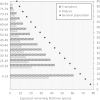Renal replacement therapy in Europe: a summary of the 2011 ERA-EDTA Registry Annual Report
- PMID: 25852881
- PMCID: PMC4377783
- DOI: 10.1093/ckj/sfu007
Renal replacement therapy in Europe: a summary of the 2011 ERA-EDTA Registry Annual Report
Abstract
Background: This article provides a summary of the 2011 ERA-EDTA Registry Annual Report (available at www.era-edta-reg.org).
Methods: Data on renal replacement therapy (RRT) for end-stage renal disease (ESRD) from national and regional renal registries in 30 countries in Europe and bordering the Mediterranean Sea were used. From 27 registries, individual patient data were received, whereas 17 registries contributed data in aggregated form. We present the incidence and prevalence of RRT, and renal transplant rates in 2011. In addition, survival probabilities and expected remaining lifetimes were calculated for those registries providing individual patient data.
Results: The overall unadjusted incidence rate of RRT in 2011 among all registries reporting to the ERA-EDTA Registry was 117 per million population (pmp) (n = 71.631). Incidence rates varied from 24 pmp in Ukraine to 238 pmp in Turkey. The overall unadjusted prevalence of RRT for ESRD on 31 December 2011 was 692 pmp (n = 425 824). The highest prevalence was reported by Portugal (1662 pmp) and the lowest by Ukraine (131 pmp). Among all registries, a total of 22 814 renal transplantations were performed (37 pmp). The highest overall transplant rate was reported from Spain, Cantabria (81 pmp), whereas the highest rate of living donor transplants was reported from Turkey (39 pmp). For patients who started RRT between 2002 and 2006, the unadjusted 5-year patient survival on RRT was 46.8% [95% confidence interval (CI) 46.6-47.0], and on dialysis 39.3% (95% CI 39.2-39.4). The unadjusted 5-year patient survival after the first renal transplantation performed between 2002 and 2006 was 86.7% (95% CI 86.2-87.2) for kidneys from deceased donors and 94.3% (95% CI 93.6-95.0) for kidneys from living donors.
Keywords: end-stage renal disease; incidence; prevalence; renal replacement therapy; survival.
Figures





References
-
- ERA-EDTA Registry. Amsterdam, the Netherlands: Academic Medical Center, Department of Medical Informatics; 2013. ERA-EDTA Registry Annual Report 2011.
LinkOut - more resources
Full Text Sources
Other Literature Sources

